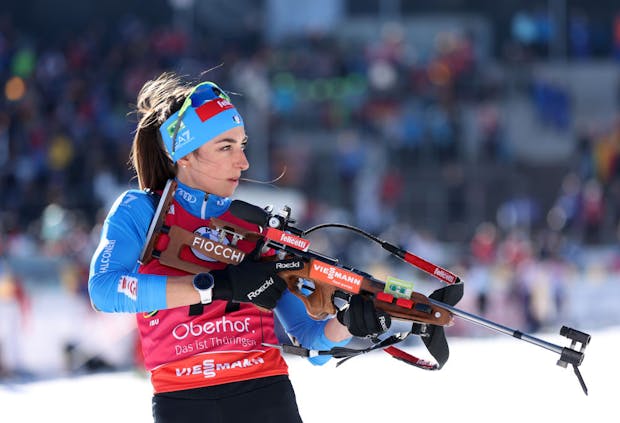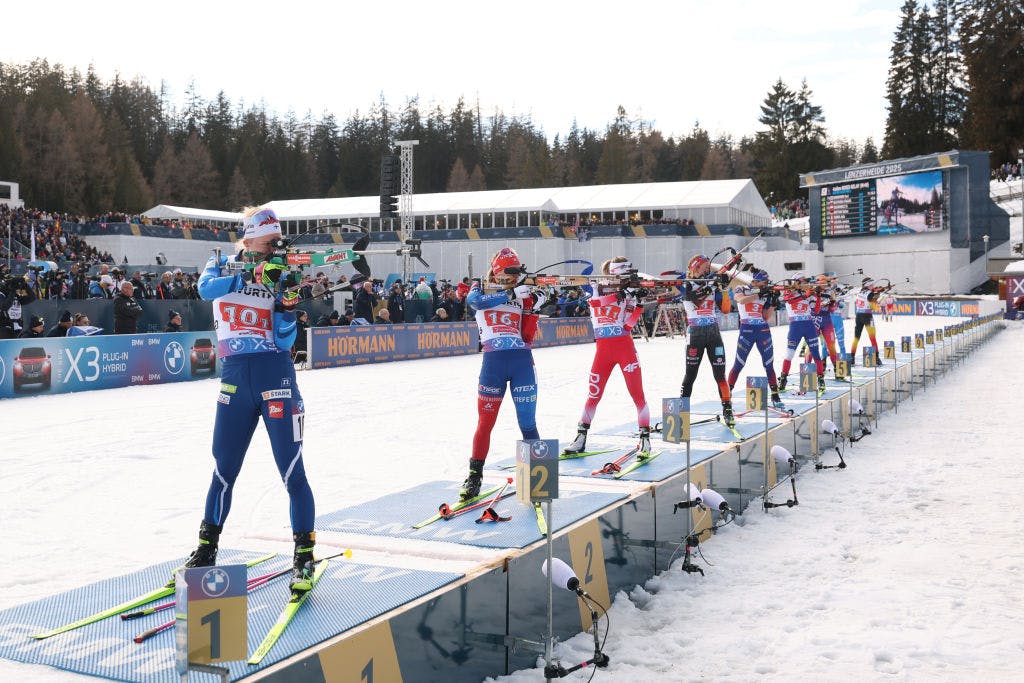
New AI-based shooting range cameras fully incorporated at the Biathlon World Championships are designed to drive a higher audience for the sport ahead of negotiations for rights deals beyond 2030.
The cameras deployed at the flagship event which began today (Wednesday) in Lenzerheide, Switzerland allow rights-holding broadcasters to choose feeds at no additional cost from shooting lanes featuring their country’s athletes.
By rolling out the project, the International Biathlon Union (IBU) is following in the footsteps of the likes of tennis Grand Slams and the PGA Tour by developing additional feeds (or an enhanced world feed) to cover local stars in a bid to strengthen its negotiating hand.
The system, co-financed by the IBU and the European Broadcasting Union (EBU) on a 65-35 basis, means that biathlon’s rights-holding broadcasters no longer just have to rely on a world feed showcasing the top performers. Under its ‘Target 2030’ strategy plan, the IBU has not only detailed plans to tap into new technologies but also set itself the target of increasing its global audience by 25 per cent by 2030.
Across the 30 shooting lanes, officials log the athletes into their respective lane which initiates a system notifying a national broadcaster that its athlete is in position and the feed is ready to take. An additional feed, dubbed ‘Lane 31’, has been set up from the mixed zone for broadcasters who don’t want the additional cost burden of sending an editorial crew but can feed through questions to be asked.
Having been rolled out at the start of the 2024-25 IBU World Cup season, 13 EBU members have taken the AI feeds so far. Top audiences in target markets such as Poland (TVP) and Switzerland (SRG SSR) have shown uplifts of 12.5 per cent and 40 per cent, respectively, according to IBU secretary general Max Cobb.
He told SportBusiness that the IBU was “playing the long game” ahead of the expiry of its global EBU rights deal in five years’ time as it seeks to buck wider viewing trends and head into negotiations on the back of an audience jump in developing biathlon markets.
“We see changes in linear viewership, but we also believe that live sport is where viewership will continue to run strong,” remarked Cobb. “Our ambition is to ensure that more countries have more biathlon viewers.
“In the long run, those are the drivers for our whole economic model. As rights fees get harder and harder to secure [because of caps being put in place by the national broadcasters], we need to be a sport everyone can’t live without in the winter sports landscape.
“We want to use this time when we don’t need to be worried about negotiating our next rights deal to really build the audience and ensure we remain strong in the countries where we have had traditional audience and grow in the countries where we haven’t traditionally had a broad audience.”
The targeted audience jump will, Cobb hopes, also add more value to the IBU’s sponsorship rights ahead of the next agency contract, also from 2030-31 onwards. Infront is the IBU’s incumbent sponsorship sales agency in an association that dates back to 1994 when APF Marketing Services – later bought by Infront – was awarded the first contract.
EBU member take-up, content hub
The EBU has held global rights to IBU events since 2002-03. Its latest four-year extension, running from 2026-27 to 2029-30 and comprising exclusive global broadcast rights, was announced seven months ago.
The EBU agreement underpins the vast majority of the IBU’s annual revenues from media rights and sponsorship. In the 12 months to April 30, 2024, this revenue stream was €43.9m ($45.5m). The IBU’s Target 2030 plan includes the distinctly punchy target of a doubling of all revenues.
Over two decades, the number of EBU members and associate members regularly broadcasting IBU events has risen from 10 to 25. The distribution has a very European bent, however, and the IBU acknowledges that it needs to identify stronger broadcast partners in other continents who will promote the content.
Along with Poland’s TVP and Switzerland’s SRG SSR, 11 EBU members have taken the AI shooting range feeds introduced at the start of the 2024-25 IBU World Cup season. These include Estonia’s ERR, Finland’s YLE, Norway’s NRK and TV2 and, most recently, Slovenia’s RTVS.
French rights-holder L’Équipe joined NRK and TVP in partaking in live tests of the AI offering at last year’s World Championships. The shooting lane feeds have proved particularly useful in France, a strong biathlon market, as L’Équipe can now commit to showing all French athletes regardless of their finishing position.
The EBU is co-funding the system after shaving off costs by agreeing to no longer produce live coverage from the second-tier IBU Cup events. Host broadcast and production services, contract management, project coordination and implementation services are also part of the EBU’s new contract running to 2030.
For Lenzerheide’s World Championships, the EBU appointed Actua Sport as host broadcaster with the 33 cameras deployed including a 450-metre cable camera, drone footage and super-slow-motion technology.

The range camera feeds, which rely on the technology of the Sweden-based New Century Production, are also provided to the EBU’s Eurovision Sport OTT streaming service and for coverage in dark markets.
The launch of a ‘Content Hub’ with the EBU in 2022-23 formed part of the scope of the current rights agreement. It has been put in place as a central resource for athletes, national federations and broadcasters as the IBU looks to develop its digital reach.
AI clips from the shooting range are being uploaded to the hub at this year’s World Championships so that athletes can share them to their social media platforms after the required holdbacks for the carved-out rights. The clipping cost is borne by both the IBU and EBU.
An athlete content creator has been hired to the IBU communications team, and an app is being developed to better facilitate the downloading of clips and posting to athletes’ socials. Athlete content sharing programmes have become increasingly prevalent for federations. Organisers of the inaugural multi-sports European Championships in 2018 were among the first to adopt such an initiative.
“While we’re proud to have the highest level of engagement on owned social media platforms of any winter IF [international federation], we still recognise that if we help the athletes do that better, it’s going to be a multiplying effect,” reflected Cobb. “They’re going to drive younger and stronger dedication from the audience that we feel will drive people to become regular viewers.”